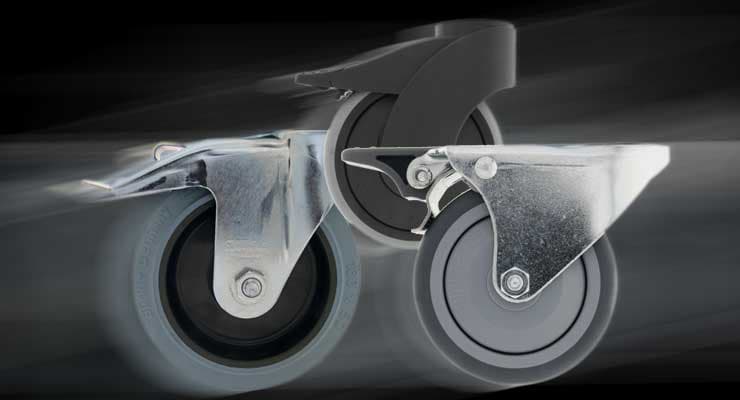
In the beginning was the wheel.
Or was it the castor? Let's cast(or) our mind down knowledge lane...
Rolling and rolling and rolling and rolling. In the catering field, every type of mobile unit is on the move – from serving and clearing trolleys, tray transport trolleys and shelf trolleys to mobile front cooking stations and moving food serving modules.
Lots of different units traverse a wide variety of floor coverings: tile, screed, synthetics, laminate, linoleum, parquet, concrete, asphalt, wooden floorboards...this is where the challenge of choosing the right castor begins.
It's the castor which essentially determines the manoeuvrability (and therefore the ergonomic handling) of a unit. At the same time, floors have to be protected against unsuitable loading and unsightly discolouration.
That's why responsible equipment manufacturers offer a wide range of castor versions. Here's our ultimate guide to technical terms and special features. Let's get cast(or)ing!
Wheel or castor?
All right, all right. In the beginning was fire, of course. The second most important invention of humanity certainly has to be the wheel, though. Our pivotal question of "wheel or castor?" is very easy to answer:
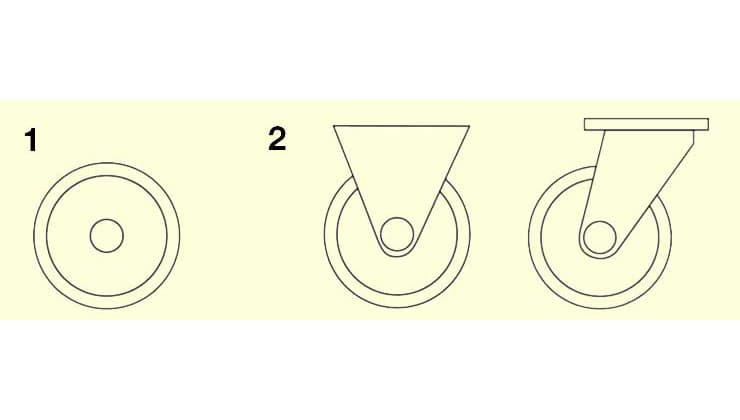
©Blickle
By definition, a wheel (1) is a running surface (i.e. wheel surface or tyre), a rim (wheel body) and a wheel bearing.
A castor (2), on the other hand, is a wheel with a "home" – i.e. a housing. The housing makes it possible to attach the wheel to a piece of equipment, thereby making it mobile. Depending on the requirements, the housing can be made of various different materials such as sheet steel, stainless steel and synthetics.
Both castor types make movement possible, but they do it in different ways. It's the housing that makes the difference here. Steering castors (Fig. 2) have a bearing integrated into the housing which enables it to swivel.
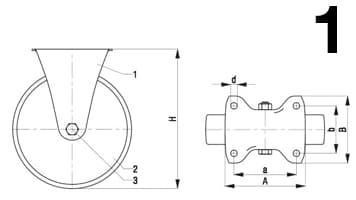
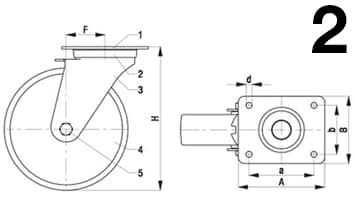
©Blickle
Steering castors simply enable directional changes and make a unit manoeuvrable. Fixed castors (Fig. 1), on the other hand, have a fixed position in the housing and run straight in one direction. This means they give the unit the desired directional stability.
The wheel: a well-rounded object with lots of properties
The whole topic gets a little more complex when it comes to different wheels. It's the clever combination of a running surface (tyre), surface hardness, bearing type and castor diameter which largely determines the castor's running properties. This also makes the castor an essential quality feature of a mobile unit.
The running surface
An important feature for areas of use and running behaviour of the castors is the running surface (tyre). A very wide variety of different materials can be used here. Common versions in the catering field include castors made of rubber, synthetics and pneumatic tyres.
Rubber running surfaces
Running surfaces made of rubber are characterized by high travelling comfort and being gentle on floors. However, black rubber can leave dark marks behind on sensitive surfaces. This is why manufacturers of high-quality equipment only use the so-called "traceless grey" rubber running surface. When selecting a unit, be sure to pay attention to this quality feature.
So not all rubber is alike, but what's the difference?
Standard solid rubber
Solid rubber tyres are the commonly used standard for transport units. They're quiet, gentle on floors, impact-resistant and they dampen vibrations. Solid rubber castors are also highly suitable for uneven floor surfaces.
Two-component solid rubber
Two-component solid rubber tyres offer high travelling comfort, are very gentle on floors and dampen vibrations. Thanks to their hard bead heel and highly elastic running surface, two-component solid rubber tyres are superiorto common solid rubber tyre thanks to their higher load-bearing capacity and lower starting and rolling resistance.
Elastic solid rubber
Elastic solid rubber tyres are based on a special rubber mixture with a high proportion of natural rubber for very elastic and impact-absorbing running behaviour. Compared to standard solid rubber, they offer better suspension and less rolling resistance, as well as a higher load-bearing capacity. They roll very quietly, are gentle on floors and are also highly suitable for uneven floor surfaces.
Thermoplastic rubber elastomer (TPE)
Tyres and running surfaces made of TPE are traceless and characterized by their durability. Thermoplastic rubber elastomers exhibit quiet running with comparatively low rolling and swivelling resistance.TPE castors are also suitable for uneven floors. TPE running surfaces can easily retain oil, which means that they can cause contact discolouration on sensitive surfaces.
Synthetic (polyamide) running surfaces
The frequently used material polyamide (PA) is a thermoplastic synthetic. This type of synthetic is unbreakable & traceless, does not cause contact discolouration and is both corrosion-resistant & odourless. Polyamide wheels are longer lasting & tougher and experience considerably less abrasion than conventional synthetic wheels made of polypropylene (PP). Polyamide wheels ensure easy running on smooth floors, high chemical resistance, low starting resistance and maintenance-free handling. On uneven floors, however, they can sometimes be jerky, and the wheels create louder rolling noises than rubber wheels.
Wheels with pneumatic tyres
Air-filled rubber tyres are extremely gentle on floors and dampen vibrations. They also offer maximum travelling comfort and low rolling resistance, even if floor conditions are poor. To ensure optimum use and a long service life, it's recommended to maintain the specified tyre pressure and check it regularly.
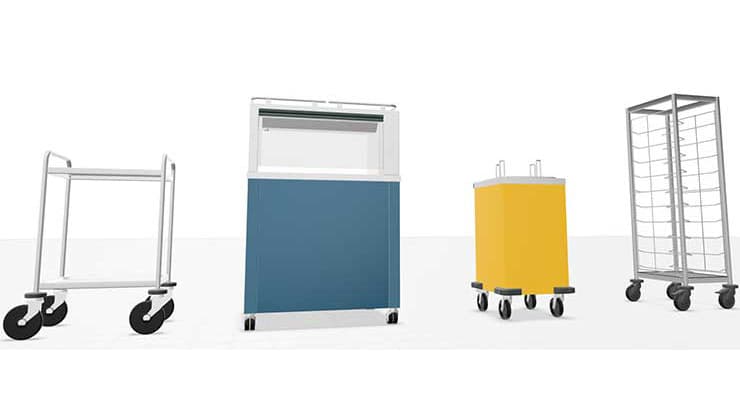
Castor version examples (from left to right):
SW 6 x 4 with four pneumatic-tyred steering castors (180 mm dia.), COOK cooking station I-flex 2plate dispenser TS 1 with four stainless steel steering castors, two of which have a brake (125 mm dia.) and tray clearing trolley 10/12 KN with four synthetic steering castors, two of which have a brake (125 mm dia.)
Hardness
Generally speaking, a harder running surface is better for soft floors and a softer running surface is better on hard floors. The hardness of the running surface is determined using the so-called Shore hardness scales. The Shore A scale is used for "softer" rubber, whereas the Shore D scale is usually used for "harder" rubber.
A running surface of "80 Shore A" is harder than one of "65 Shore A" (the higher the number, the harder the surface). As well, a value from the D scale is always harder than one from the A scale. A standard car tyre, for example, has a hardness of "65 Shore A", whereas a solid truck tyre is "50 Shore D" and a golf ball is "60 Shore D".
The wheel bearing (bearing type)
The wheel bearing is of major importance to the running properties of a castor and the manoeuvrability of a unit. Wheel bearings have to be attuned to the type of use the unit will see, where values like load-bearing capacity, duration of use, environmental influences, starting & rolling resistance and weather resistance have to be taken into account.
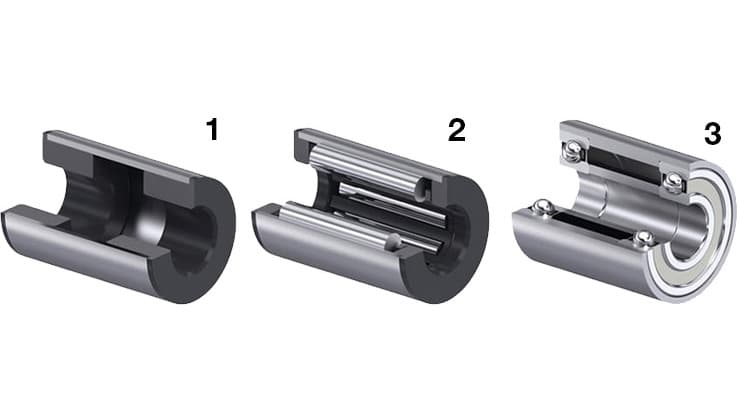
©Blickle
Sliding bearing (1)
The sliding bearing is a simple, cost-effective and rugged wheel bearing. It's also corrosion-resistant and, under normal usage conditions, maintenance-free. Under certain conditions, such as a dry environment, a highly dusty environment or after a long period of use, lubrication with grease or oil is recommended.
Roller bearing (2)
The roller bearing is a sturdy, durable and largely maintenance-free wheel bearing which requires only minimal installation space. Roller bearings (also called roller cage or needle bearings) feature minimal radial bearing play and have primarily proven themselves in conjunction with transport unit castors. As rolling friction, rather than sliding friction, occurs during rotation around the axle, the rolling resistance of the wheel is relatively low, even with higher loads. Roller bearings are usually lubricated with long-lasting grease during assembly, so they generally don't need to be re-lubricated.
Ball bearing (3)
Deep groove ball bearings (also called precision ball bearings) meet the highest demands on load-bearing capacity, running properties (including at higher speeds) and resistance to environmental influences which a wheel bearing is subjected to.
Deep groove ball bearings exhibit the smallest bearing play and are primarily used in technically demanding transport unit castors and heavy-load castors. This wheel bearing type features very precise, smooth running. Ball bearings are lubricated with long-lasting grease during assembly. Wheels featuring sealed ball bearings may not be re-lubricated, as this can damage the bearing.
Castor diameter and temperature
As you now know, the proper term is actually wheel diameter, though castor diameter has become a commonly used term. With most units, the diameter of the castors is already matched to the respective unit/usage combination ex works. Generally speaking, the larger the castor diameter, the easier it is to manoeuvre the unit. The use of smaller wheels can often make sense to suit the combination of the unit, castor materials and application, though.
The material combination of the castor influences its temperature resistance. This is why it's important to match the temperature range of the castor to your needs when making a purchase. Is the unit being used in a cold storage house? Does it have to withstand high ambient temperatures? With all mobile units, the available castors should be matched to your requirements.
It's all about the castor
Don't worry, you don't need to be an expert in the Shore scale, wheel versions or bearing types now. A good equipment manufacturer's professionals will be happy to advise you well in selecting the right castors – they'll make sure you always run smoothly going forward.
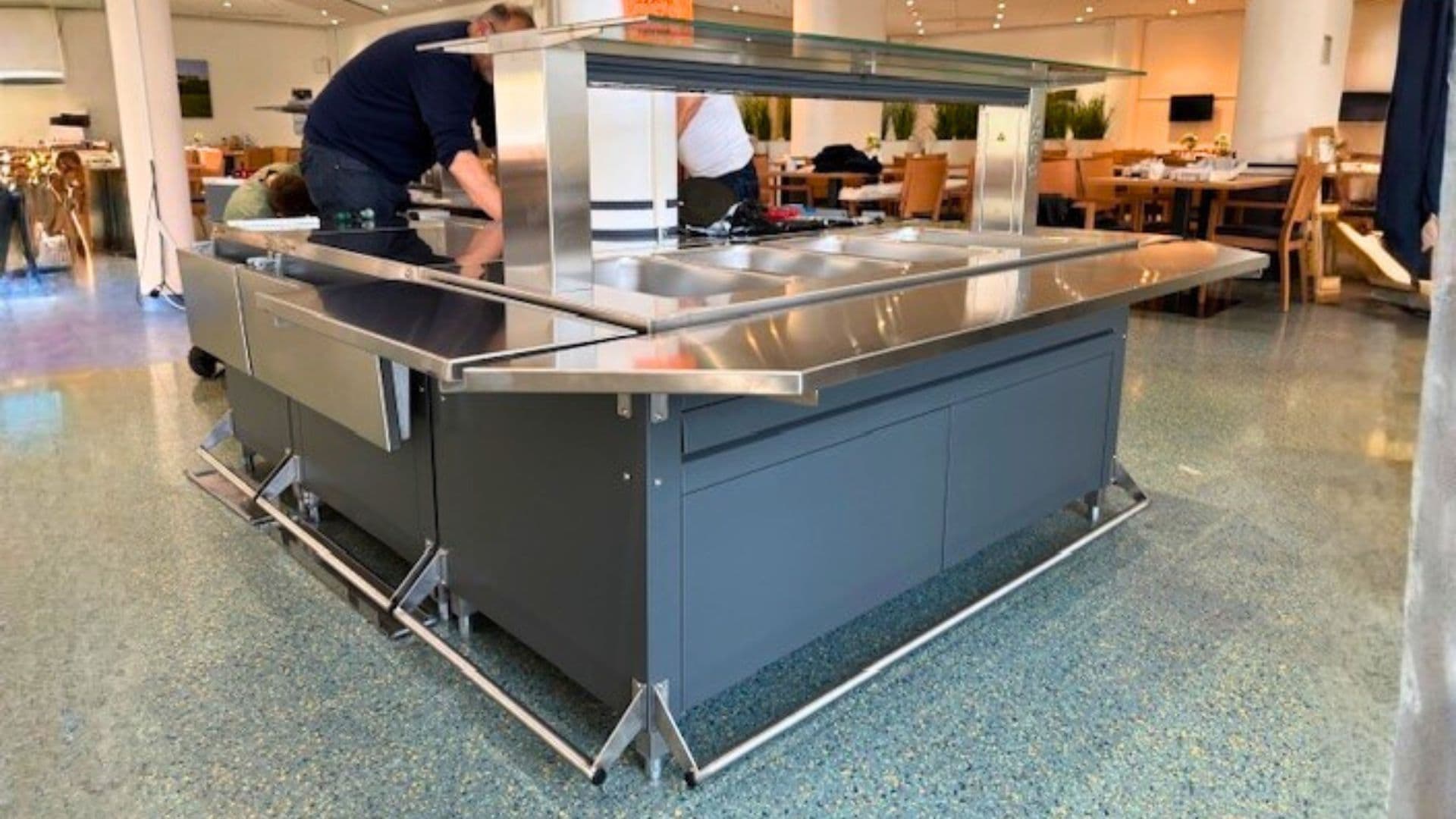 Reference B.PRO - VAMED Klinik Hagen-Ambrock
Reference B.PRO - VAMED Klinik Hagen-AmbrockThe hospital VAMED Klinik Hagen-Ambrock needed a new food serving line to enable patients in wheelchairs to participate in the food serving process. Regional Sales Manager Sven Nowacki reveals how it was possible to make this wish a reality within just a few weeks and without any construction work.
 A portrait of B.PRO France
A portrait of B.PRO FranceHow does B.PRO work in one of the most demanding markets in Europe? General Manager Daniel Rewell offers insights into key product focuses, customer structures and the most important development topics.
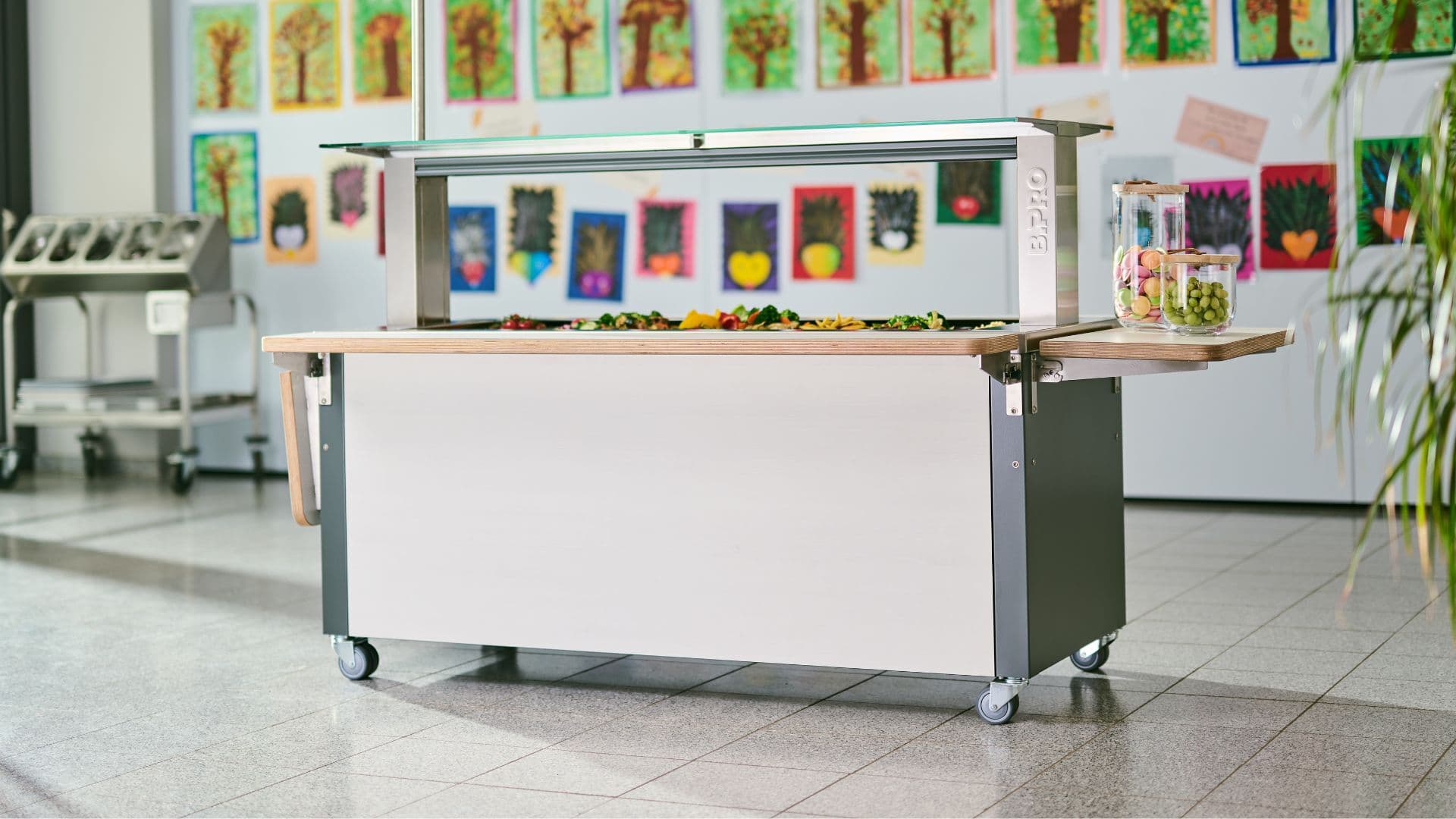 New buffet products
New buffet productsA convincing presentation, flexible functions and accessibility: Buffets have to meet a lot of requirements today. This is precisely why B.PRO has comprehensively revised the BASIC LINE - from optimised cooling technology to new solutions for the youngest of guests.
